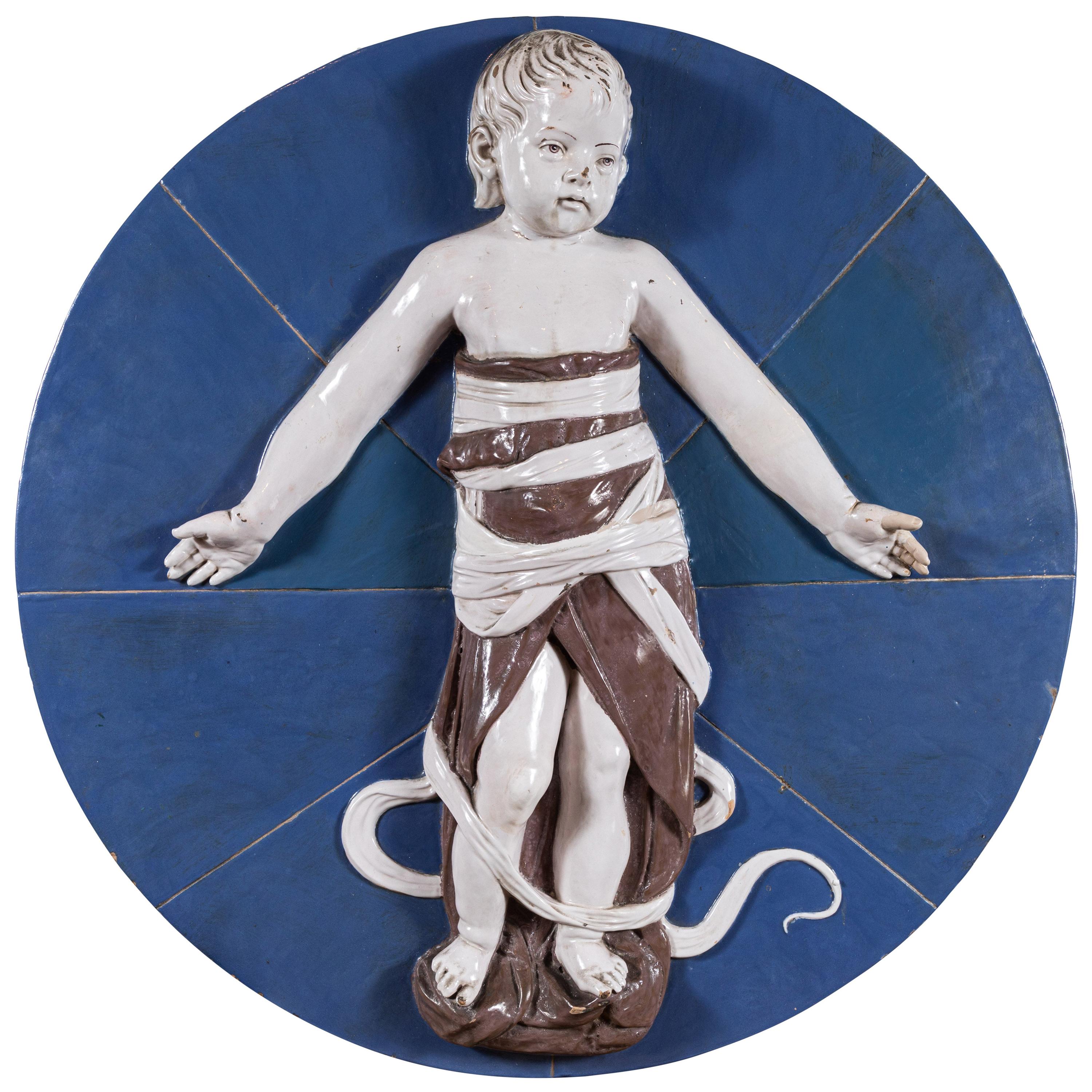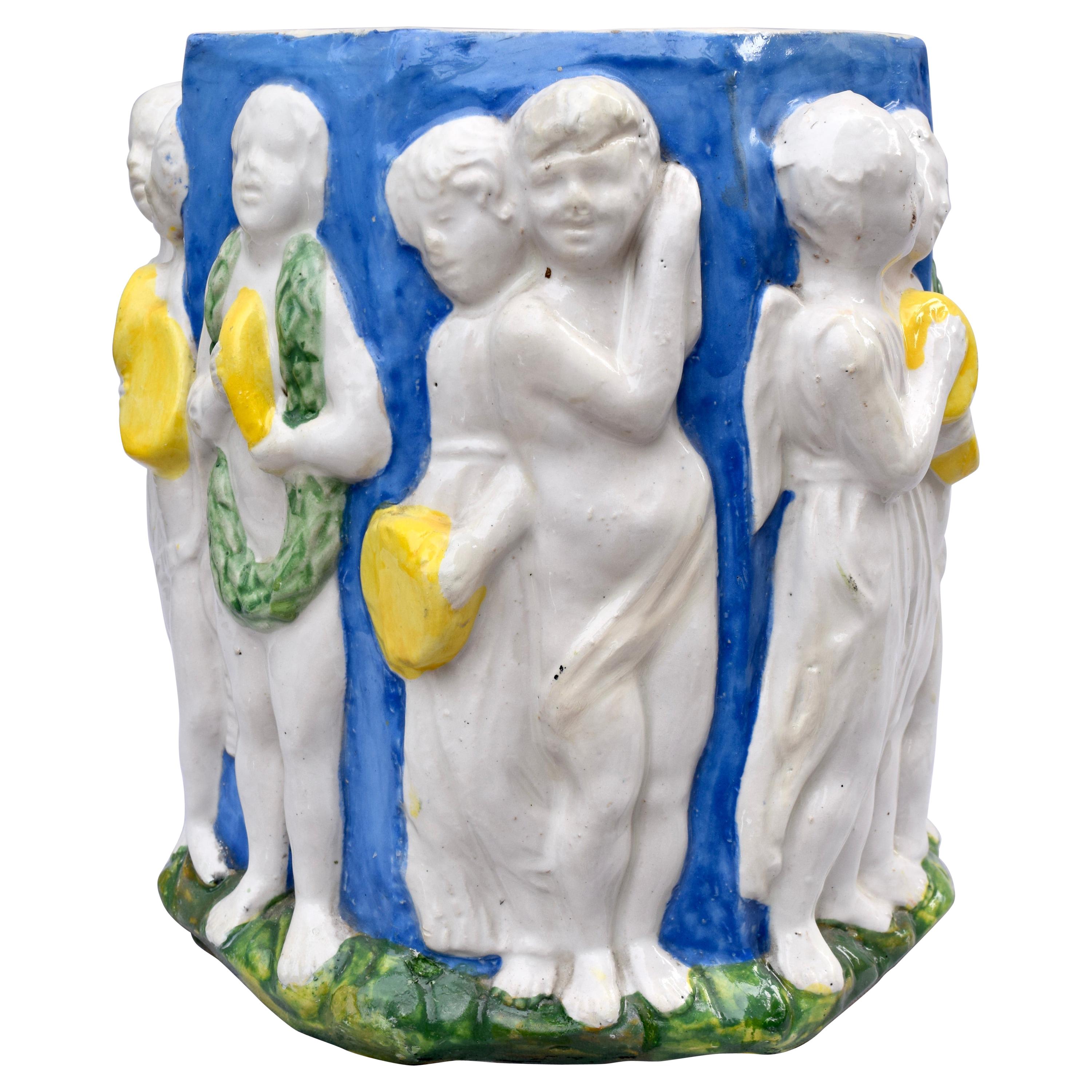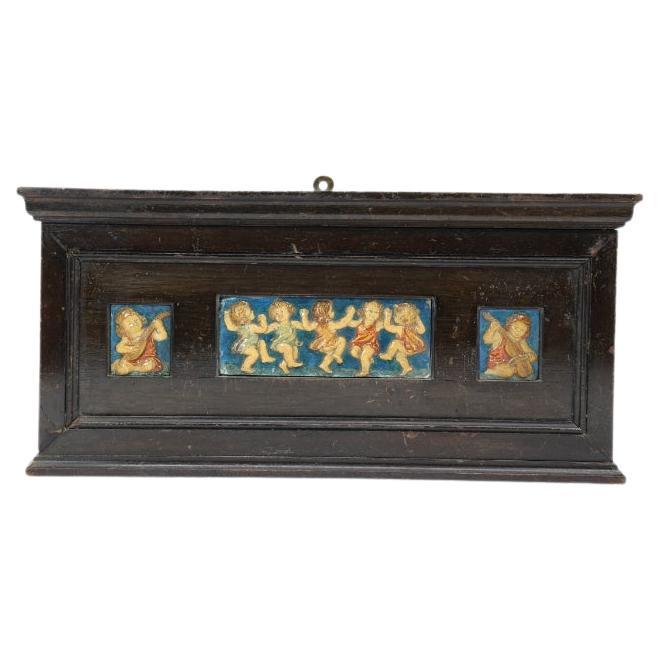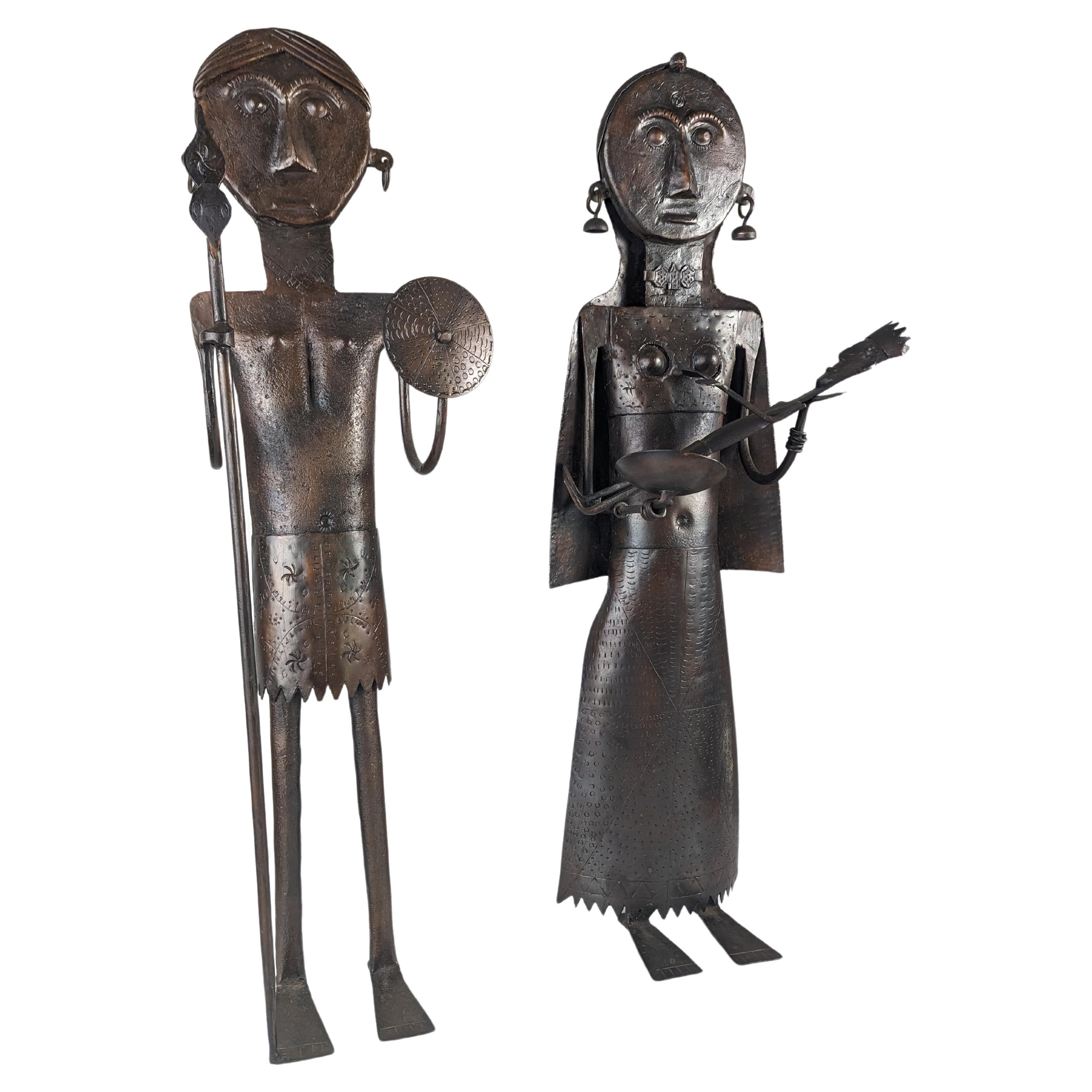Items Similar to Fra Mattia Della Robbia, Saint Joseph, Tuscany, Around 1505-1510
Want more images or videos?
Request additional images or videos from the seller
1 of 5
Fra Mattia Della Robbia, Saint Joseph, Tuscany, Around 1505-1510
About the Item
Fra Mattia Della Robbia (Firenze 1468-1534)
Saint Joseph
Terracotta
Tuscany, around 1505-1510
55 x 40 x 30 cm
Marco della Robbia the Younger (April 6, 1468 in Florence - 1534) dit Fra 'Mattia Della Robbia is an Italian monk and sculptor member of the Italian artist family Della Robbia, one of Andrea's five sons.
Modeled in terracotta, a medium that allows for greater realism compared to the abstract preciousness of enamelled ceramics, this sculpture is representative of the rich production of "presepi" which reached its peak in Florence between the end of the 15th century and the beginning of of the 16th century.
A sculpture of Saint Joseph comparable to this one was made for the Spedale degli Innocenti in Florence, a 15th century building by Brunelleschi, today on display at the eponymous museum. The presepi of Fra Ambrogio and Fra Mattia are, like our Saint Joseph, made of cold-painted terracotta.
The subjects made for official commissions were often reiterated for private commissions, eager to compete with the city's most important aristocratic families by offering themselves the works of the most prestigious artists of their time as a means of social distinction.
This sculpture of Saint Joseph was probably part of a complete crib realized by Fra Mattia della Robbia and the workshop and inspired by the famous model still preserved at the Ospedale degli Innocenti.
- Attributed to:Della Robbia (Artist)
- Dimensions:Height: 21.66 in (55 cm)Width: 15.75 in (40 cm)Depth: 14.57 in (37 cm)
- Style:Renaissance (Of the Period)
- Materials and Techniques:
- Place of Origin:
- Period:
- Date of Manufacture:1510
- Condition:Minor losses. One hand is missing.
- Seller Location:Bruxelles, BE
- Reference Number:1stDibs: LU6666233714812
About the Seller
5.0
Vetted Seller
These experienced sellers undergo a comprehensive evaluation by our team of in-house experts.
1stDibs seller since 2022
6 sales on 1stDibs
Typical response time: 5 hours
- ShippingRetrieving quote...Ships From: Bruxelles, Belgium
- Return PolicyA return for this item may be initiated within 3 days of delivery.
More From This SellerView All
- Cercle of Jacopo della Pila - Marble relief depicting a winged CherubLocated in Bruxelles, BECercle of Jacopo della Pila (Lombard, in Naples 1471-1502) Marble relief depicting a winged Cherub Naples, second half of15th century 40 x 57 x 12 cm Exquisitely carved, this relief portrays a winged cherub with cascading hair and delicate features. The cherub's plump, smooth countenance, rounded cheeks, outlined lips, and finely drawn nose emanate a sense of tenderness. The quadrangular module, is adorned with a carved frame. The relief ascends gradually, transitioning from the low relief of the wings to the high relief of the head. The rectangular frame and the subtly curved form of the artwork suggest that the relief likely adorned the upper part of an arch or a vaulted chapel. The type is that of the perspective room with a coffered ceiling decorated with figures of winged cherubs, which is found in various Neapolitan chapels of the 15th century. Coffered ceilings attest to the recovery of antiquity and the search for luxury in Renaissance architecture, first in Florence, then in Rome and Naples. The majority of the numerous family chapels and tombs built during the late fifteenth century in south of Italy employ the new formal vocabulary of the Florentine Renaissance in a self-confident manner that permitted a broad spectrum of variations. The escalating admiration for the classical world, coupled with the development of perspective, significantly contributed to the Renaissance endorsement of coffered ceilings. This artistic and constructive device drew inspiration from the intricate marble patterns observed in historical landmarks such as the Arch of Titus, the Temple of Vesta in Tivoli, the Pantheon, and the Basilica of Maxentius. A distilled product of both mathematical and artistic cultures, deeply scrutinizing the ancient world, the coffered ceiling plays a vital role in the perspective construction of space with its regular and directional geometry. The motif of the coffered ceiling decorated with cherubs in relief was introduced in Naples by Francesco Laurana in the plastic decoration of the Arch of Castelnuovo. Laurana's impact on the art scene in the south of Italy was profound. The introduction of the winged cherub into the region's artistic vocabulary bridged the gap between the classical and the contemporary, creating a synthesis that resonated with both aesthetic and spiritual sensibilities. His influence extended beyond the immediate visual appeal, shaping the cultural identity of the Renaissance in southern Italy. Although the plastic decoration of the Arch of Castelnuovo cannot certainly be ascribed to a mature Renaissance style, it was precisely on this occasion that the sculptors who worked there could get to know and export throughout the Italian peninsula that type of "Florentine classicism" which, even in the 15th century Naples, was conditioned by the Burgundian culture imported into the Kingdom by Alfonso of Aragon himself, with artists called from Spain and Northern Europe. The coffered ceiling, with its geometric patterns and Laurana's winged cherubs nestled within, became a symbol of refinement and cultural sophistication. The relief sculptures, carefully integrated into the overall design, transformed the ceiling into a celestial realm, inviting viewers to contemplate the divine while immersed in the grandeur of the Renaissance space. Similar winged cherubs appears also in the Naples cathedral. Within the renowned Succorpo Chapel, a mesmerizing marble coffered ceiling adorned with cherubs epitomizes the splendor of the Neapolitan Renaissance. The interplay of light and shadow on the textured surface of the marble coffered ceiling introduces an ethereal dimension, providing an immersive visual experience for observers. The geometric precision and the repeated patterns, reminiscent of classical motifs, establish a sense of harmony and balance that has become the hallmark of the Neapolitan interpretation of Florentine Renaissance aesthetics. Although probably intended to be admired from a distance, this cherub is intricately detailed and exquisitely rendered: the face and hair are elegantly outlined and the feathers are textured through juxtaposed lines. The marble, both figurative and decorative, adheres to the principles of balance and restrained ornamentation typical of the « Florentine Classicism ». Harmonious shapes and gracefully orchestrated curves , rooted in the classical repertoire, converge to evoke a sense of ethereal beauty. The surface displays the masterful use of a chisel to intricately carve the feathers and facial features, creating an almost abstract quality. This work is a testament to a sculptor of great skill and rich figurative knowledge, seamlessly blending classical firmness in contours with a refined treatment of the marble's surface. The combination of tradition and innovation point to a stylistic idiom from Lombardy, in particular we can find some comparaisons with the works of Jacopo della Pila, sculptor of Lombard origin working in Naples in the second half of the 15th century. He is documented there between 1471 and 1502, and is a protagonist of the Aragon Renaissance in the second half of the Quattrocento, together with the other great Northern sculptor active in the kingdom, Domenico Gagini. the first commission he received dates back to August 9, 1471, when Jacopo publicly committed to sculpting the funerary monument of Archbishop Nicola Piscicelli to be placed in the Cathedral of Salerno. The last known work is an altar ordered on July 29, 1502, by the noble Jacopo Rocco for the church of San Lorenzo Maggiore in Naples. Between these two chronological extremes (1471-1502), we must place the fervent activity of the artist, who had trained in Rome, perhaps under the guidance of Paolo Romano but also engaged in dialogue with other major artists of the city, especially Isaia da Pisa. He enriched his experience in Naples, initially drawing inspiration from the works of Domenico Gagini and later from the Tuscan masterpieces of Antonio Rossellino and Benedetto da Maiano destined for the church of Santa Maria di Monteoliveto. Jacopo della Pila's artistic personality is thus based on a complex interplay of influences, contributing to the definition of a highly personal style. Close comparaison can be made between our cherub and the winged angels reliefs...Category
Antique 15th Century and Earlier Italian Renaissance Figurative Sculptures
MaterialsMarble
- Cercle of Romano Alberti, Page, Around 1530-1540Located in Bruxelles, BECercle of Romano Alberti, dit Il Nero da Sansepolcro ( San Sepolcro, 1521-1568 ) Page Mixed media : wood core, papier mâché, stucco, polychrome and gilded Italy, around 1530-154...Category
Antique 16th Century Italian Renaissance Figurative Sculptures
MaterialsStucco, Wood, Paper
- Agnolo di Polo Firenze 1470 - Arezzo 1528' - Saint Nicholas of TolentinoLocated in Bruxelles, BEAgnolo di Polo (Firenze 1470 - Arezzo 1528) Saint Nicholas of Tolentino Around 1510-1520 Painted and gilded terracotta 55.5 x 24 x 16.5 cm San Nicholas de Tolentino is represe...Category
Antique 16th Century Italian Renaissance Figurative Sculptures
MaterialsTerracotta
- Plateau with two breasts, attribute of Saint Agatha - 17th centuryLocated in Bruxelles, BEPlateau with two breasts, attribute of Saint Agatha Southern Italy, 17th century Polychrome and gilded wood 20 x 14,5 x 15 cm Born into a noble lineage, Agatha came into the world ...Category
Antique 17th Century Italian Baroque Figurative Sculptures
MaterialsWood
- Large Cast and Chiseled Bronze Plaque - Saint Sebastian, Rome 17th centuryLocated in Bruxelles, BELarge Cast and Chiseled Bronze Plaque Saint Sebastian after the model by Guido Reni (Capitoline Museum) Rome, 17th century Large rectangular bronze plaque depicting the martyrdom of...Category
Antique 17th Century Italian Baroque Figurative Sculptures
MaterialsBronze
- Bronze Mortar, Tuscany, Second Half of 16th CenturyLocated in Bruxelles, BEBronze mortar with garlands, flowers and putti - Tuscany , second half of 17th century. Measures: height 10 diameter : 13 cm Artisans and healers used mortars for grinding food...Category
Antique 16th Century Italian Renaissance Scientific Instruments
MaterialsBronze
You May Also Like
- Grand, 19th Century, Della Robbia MedallionBy CantagalliLocated in Newport Beach, CAExtremely large, hand molded, painted, and majolica-glazed, relief sculpture "Tondo" (meaning "art in the round") after famed Renaissance artist, Andrea della Robbia...Category
Antique 1880s Italian Renaissance Wall-mounted Sculptures
MaterialsTerracotta
- Della Robbia VaseBy Della Robbia PotteryLocated in Chipping Campden, GB5484 Large Della Robbia Vase decorated in an Art Nouveay Design of Stylised Tulips below a scolloped neck by Charles Collis Light crazing with a little staining to the neck and a gla...Category
Antique Early 1900s Vases
MaterialsEarthenware
- Italian Della Robbia Terra-Cotta PlanterBy Della Robbia PotteryLocated in Southampton, NJA scarcely seen early 20th century high relief hand made & painted polychrome glazed Terra Cotta pottery planter in the manner of Della Robbia. Nice weight...Category
Early 20th Century Italian Renaissance Planters, Cachepots and Jardinières
MaterialsPottery, Majolica
- Ellen Mary Rope for Della Robbia. Small picture frame with three plaster plaquesBy Della RobbiaLocated in London, GBEllen Mary Rope for Della Robbia Pottery. A small picture frame with three plaster plaques in their original ebonized frame. Depicting a child playing the Lute to the left-hand plaqu...Category
Antique Early 1900s English Arts and Crafts Picture Frames
MaterialsPottery, Beech
- Saint Joseph and Virgin with Child candlestick sculptureLocated in Benalmadena, ESFantastic large sculptures with their 68 cm high representing Saint Joseph and the Virgin Mary with the baby Jesus in her arms made of metal with great quality craftsmanship and atte...Category
Late 20th Century Figurative Sculptures
MaterialsMetal
- Lizzie Wilkins Della Robbia Birkenhead Arts & Crafts VaseLocated in Bishop's Stortford, HertfordshireA stylish and sought after English Arts & Crafts twin handled art pottery vase hand painted by Lizzie Wilkins for Della Robbia Birkenhead and dated 1896. The vase of flagon shape is ...Category
Antique 1890s English Arts and Crafts Vases
MaterialsTerracotta





